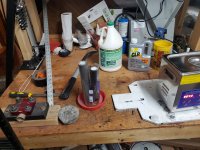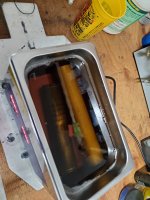TL;DR
- DSMO opens your skin to other chemicals. Like the lead, copper, carbon etc that is in the inky suppressor gunk end product.
- Thin nitrile gloves probably suck for DMSO. Goes through fast, gets “red” dangerous ratings by Kimberly Clark (a glove maker)
- Buy a pure butyl rubber glove for when handling this stuff.
- Chem gloves break down with certain chemicals (even the best glove material for that chemical). Plan on replacing them…but in this case I’m not sure if material breakdown is a factor with DMSO+Butyl Rubber.
Yeah, that guy in the vid used a 10% concentration (found in the comments). Maybe you saw that as well.
Now, just figuring out what 10:1 actually means, as far as mixing…well, I happened upon a
Quora thread that has chemists either disagreeing, agreeing but saying it differently (hinging on definitions), or talking about different types of end products.
In our case, it probably doesn’t really matter if it’s 9 drops of distilled + 1 drop of DMSO or 10 drops to 1 drop.
ANYWAY
As I seem to be the Hide’s resident “safety glove man” vis-à-vis suppressors, the best glove seems to be a pure butyl rubber one, which apparently don’t allow DMSO to permeate at all?
Viton/Butyl gloves are not great with DMSO, so do pay attention.
See p.6 of the attached Ansell pdf. Their nitrile glove seem to be ok for this stuff (Dimethyl Sulfoxide or DMSO). I’ve highlighted the relevant row. Perhaps it’s due to the glove’s thickness (they come in a variety of styles, all really thick) or special construction?
Ansell’s nitrile Solvex gloves are way thicker than mechanic’s nitrile gloves with most @ 17mils (.46mm). Some at .56mm.
View attachment 8495545
The Kimberly Clark pdf for incidental exposure for their thin nitrile exam gloves, below, also attached, I think says at a 99.99% concentration, it takes 8min for DMSO to go through a nitrile glove at a 501 pg/cm2/min permeation rate (ASTM F739-99A). Which doesn’t mean a lot to me, but they give the glove a red rating.
View attachment 8495543
So no nitrile for me when handling this stuff, even at 10% concentration.
As someone mentioned (I think), it seems by itself and with nothing else on your skin or in the DMSO solution, it’s sold over the counter as an arthritis balm and is used by veterinarians too.
As someone ALSO mentioned, DMSO affects the skin barrier, allowing whatever else is dissolved or carried in the DMSO cleaner to pass into your bloodstream. With suppressors, lead is one of those somethings. As well as copper and carbon and who knows what else.
Butyl rubber gloves of sufficient thickness are not cheap, but have lasted me a couple years with a lot of acetone use (cleaning cast iron machinery tops). Then they got tacky feeling and were thrown away.
I imagine the tackiness was caused by the slow ingress of the acetone into the rubber, which was expected, of course. Not sure what are the signs of DMSO breaking down the glove.
Most chem gloves aren’t forever, unfortunately. Certain chemicals just break down even the best glove material. However, in this case I’m not sure if material breakdown is a factor with DMSO+Butyl Rubber, given Ansell’s “—“ permeation rating for their butyl rubber glove.
Here are the ones I use at $63 bucks.
Butyl Chemical Resistant Gloves
You can also buy the 14mil version in large for a bit cheaper,
currently at $45.
Unfortunately I think, as with the Dip method of suppressor cleaning, we’re going to see a bunch of accidental poisonings with this stuff when cleaning suppressors.
As a rule, men are stupidly careless around chemicals, with stuff in the air, and around loud noises. Anything that doesn’t immediately cause blood to pour forth, basically.
I am not a chemist, but I can read (sorta) lol.
Please let me know if I’ve interpreted the PDFs wrong, the manufacturers are bunk, or if there are other resources I should be looking at.






